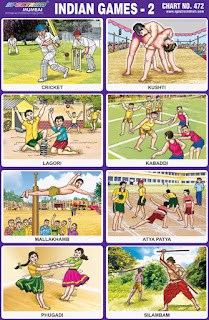 |
| Indian Games 2 Chart |
Spectrum Chart - 472 : Indian Games 2
1. Cricket – Cricket is a bat-and-ball
game played between two teams of eleven players on a cricket field.
One team, designated the batting team, attempts to score as many runs
as possible, whilst their opponents, the blowing team tries to get
opposition batsmen out for minimum runs. Cricket is popular in many
countries, mostly in Commonwealth countries. There are three formats
of the game Test Cricket, ODI's & T20's.
2. Kushti – Kushti is a form of
wrestling from South Asia. It was developed in the Mughal Empire.
Wrestling competitions, known as dangal or kushti, are held in
villages and as such are variable and flexible. The arena is either a
circular or square shape, measuring at least fourteen feet across.
Rather than using modern mats, South Asian wrestlers train and
compete on dirt floors. A win is achieved by pinning the opponent's
shoulders and hips to the ground simultaneously. Bouts are overseen
by a referee inside the ring and a panel of two judges watching from
the outside.
3. Lagori - Lagori is a game in India
involving a ball and a pile of flat stones, generally played between
two teams in a large outdoor area. A member of one team (the seekers)
throws a ball at a pile of stones to knock them over. The seekers
then try to restore the pile of stones while the opposing team (the
hitters) throws the ball at them. If the ball touches a seeker, he is
out and his team continues without him. A seeker can always safeguard
himself by touching an opposite team member before the ball hits him.
4. Kabaddi – Kabaddi is a contact sport
that originated in ancient India. Kabaddi consists two teams of seven
members each occupy opposite halves of a field of 10 by 13 metres in
case of men and 8 by 12 metres in case of women. Each team has three
supplementary players held in reserve. The game is played with
20-minute halves and a five-minute halftime break during which the
teams exchange sides.
5. Mallakhamb - Mallakhamb is a
traditional Indian sport in which a gymnast performs feats and poses
in concert with a vertical wooden pole or rope. Almost 25 to 30 types
of mallakhamba apparatus were tried and tested over the years. 16
various types are recognised presently, but for sport, only six types
are used. Mallakhamba is present in the Hind Kesari, Indian Wrestling
championship. Competitively there are three main variations of
mallakhamba.
6. Atya Patya - Atya patya is a
traditional India sport played nine to a side, between two sides. It
is more popular in rural areas of India. It is more commonly played
in Maharashtra. Atya patya is described as a "game of feints".
The playing area comprises nine trenches, coming out of either side
of a central trench, points are awarded for blocking progress across
the trenches made by one side, other side blocks this progress. It
has been described as a game of "militant chase".
7. Phugadi – Phugadi is a Goan folk
dance performed by the women in the Konkan region during Hindu
religious festivals like Ganesh Chaturthi and Vrata. Phugadi is an
art form that can be traced to the primeval cultural traditions of
Goa. It is performed during various religious and social occasions.
It is generally performed during the month of Bhaadrapada.
8. Silambam - Silambam is a weapon-based
Indian martial art from Tamil Nadu, but also traditionally practised
by the Tamil community of Sri Lanka and Malaysia. There are numerous
styles of silambam but the nillaikalakki discipline is the most
widespread style outside India. The styles differ from one another in
grip, posture, foot work, length of the stick, etc. Silambam may
either be practised for the purpose of combat or purely for
demonstration.

No comments:
Post a Comment